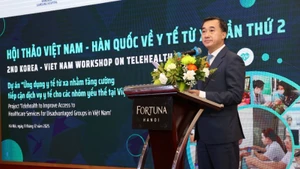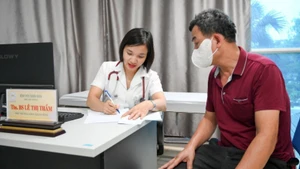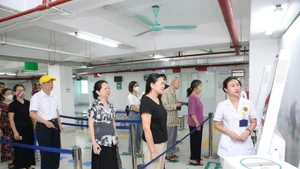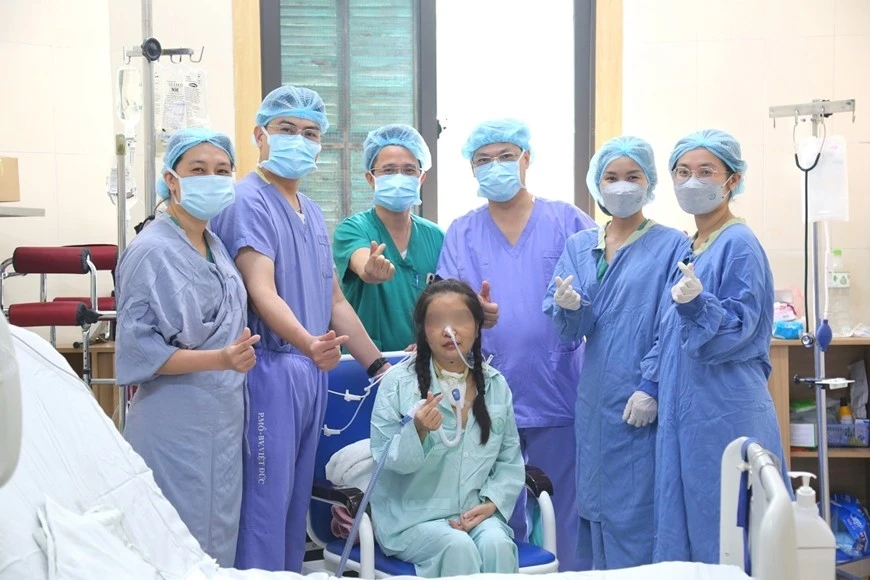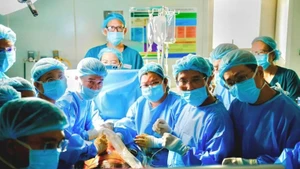Proactively preventing disease
After the historic flooding, Dak Lak, Gia Lai, and Khanh Hoa Provinces are urgently implementing post-flood recovery efforts. Military forces, police, healthcare units, youth union members, and university and college students are actively assisting local residents in cleaning houses, schools, hospitals, and government offices.
According to reporters of Nhan Dan Newspaper, these activities are being carried out continuously and urgently, with the coordination of multiple forces.
On the morning of November 24, at Hoa Son Tay Medical Station in Dong Hoa Ward, Dak Lak Province, one of the hardest-hit localities in this historic flood, we witnessed dozens of officers and soldiers from the Dak Lak Military Command working alongside medical station staff to clean mud and waste, wipe down tables, chairs, hospital beds, treatment rooms, and offices in an effort to quickly restore operations at the station.
At the same time, chemical spraying, medicine distribution, and healthcare support for residents are being ramped up to proactively prevent post-flood disease outbreaks.
Busy collecting drenched and mud-soaked records and medical documents, physician Nguyen Thi Loc, Head of Hoa Son Tay Medical Station, said that being located on the banks of the Ban Thach River, floodwaters rose almost to the roof, causing all medical equipment, devices, and medicines to be swept away or damaged.
Since the morning of November 23, after the waters receded, the station has received support from military officers and soldiers in cleaning and from the provincial Centre for Disease Control (CDC) in environmental chemical spraying. To resume operations soon and serve residents’ healthcare needs, Hoa Son Tay Medical Station has requested the Dong Hoa Regional Medical Centre and the Dak Lak Department of Health to urgently provide medical equipment, devices, and medicines.
At Vinh Phuong Medical Station in Bac Nha Trang Ward, flood recovery and disease prevention efforts are also being implemented urgently and comprehensively. Doctor Nguyen Thi Kim Cuc, Acting Deputy Head of the station, shared that right after the floods, officers from the Information Officers College and students from Nha Trang University came to support the station in cleaning and disinfecting the premises.
On the same morning, the Preventive Health Centre continued coordinating with military forces to spray disinfectants at primary and pre-school facilities, residential clusters, the medical station, and the community hall of the village. The station is also distributing Cloramin B and family medicine kits to help residents prevent diseases after the flood. In the coming days, once the station stabilises, healthcare workers will visit each residential area to guide residents on disinfection and health protection measures.
At flood-hit schools in Khanh Hoa, forces from the Southern Military Institute of Preventive Medicine (under the Military Medical Department) are working with the provincial Preventive Health Centre to urgently spray disinfectants in classrooms and surrounding areas, where disease outbreaks are likely.
Lieutenant Colonel, Doctor Pham Dinh Tinh, Head of the Department of Malaria–Parasitology–Entomology, said the unit has been assigned to disinfect 40 schools, and in the first two days, the team has completed disinfection at 11 schools.
Dedicated healthcare support for residents
In Gia Lai Province, widespread flooding caused inundation at three hospitals—Quy Nhon Psychiatric Hospital, Quy Nhon Tuberculosis and Lung Disease Hospital, and Quy Nhon Traditional Medicine–Rehabilitation Hospital. In addition, 10 medical stations in communes and wards were flooded, severely affecting healthcare services and posing a high risk of disease outbreaks.
Amid the emergency, the Provincial Department of Health instructed all subordinate health units to activate a 24/7 emergency duty regime, maintain medical examination and treatment services, and ensure maximum safety for patients and medical equipment. It also activated disaster response plans, mobilised mobile forces, and implemented support mechanisms for lower-level units in line with Ministry of Health directives.
“We aim to ensure absolute safety for residents in flood-affected areas, preventing overlapping disease outbreaks. All facilities in flood-prone areas already have evacuation plans in place to protect equipment, medicines, and supplies. The challenge now is to both overcome the aftermath and strengthen the grassroots healthcare system,” said Specialist Doctor Level II Le Quang Hung, Director of the Gia Lai Department of Health.
On November 22, two special working groups comprising 180 health personnel were deployed to the hardest-hit areas - Quy Nhon and Tuy Phuoc - to carry out post-flood environmental treatment. The teams worked with local health units to clean and disinfect water sources, prevent disease outbreaks, and distribute medicines to residents.
We aim to ensure absolute safety for residents in flood-affected areas, preventing overlapping disease outbreaks. All facilities in flood-prone areas already have evacuation plans in place to protect equipment, medicines, and supplies. The challenge now is to both overcome the aftermath and strengthen the grassroots healthcare system.
Specialist Doctor Level II Le Quang Hung, Director of the Gia Lai Department of Health
Directly inspecting and implementing disease prevention measures in flooded communes and wards, Hoang Hai Phuc, Director of the Dak Lak CDC, said that the historic flood brought huge amounts of mud and waste into residential areas, killed many livestock, and polluted water sources, creating favourable conditions for post-disaster diseases such as conjunctivitis, dengue fever, hand-foot-and-mouth disease, and diarrhoea. Therefore, the CDC has formed seven rapid response teams to support localities in epidemic prevention. The centre has also distributed sprayers and more than 10 tonnes of Cloramin B for environmental treatment, along with over 1,000 family medical kits for disease prevention.
Dak Lak Province is requesting the Ministry of Health to provide 20,000 social welfare medicine kits; 3,000 flood-prevention medicine kits; an additional 100 backpack sprayers for environmental and chemical spraying. It is also requesting five vehicle-mounted sprayers for large-scale disinfection in severely affected communes; and 500 litres of Pyrethrine for post-flood epidemic control.
Along with disease prevention, the local health sectors have instructed both public and private hospitals to overcome all difficulties and ensure proper examination and treatment for residents during and after the floods.
On November 24, at Dak Lak Obstetrics and Paediatrics Hospital, where more than 222 patients are being treated, Specialist Doctor Level I Nguyen Nhu Y, Director of the hospital, said that during the peak of the flooding, the hospital was completely isolated. With only 300 beds but accommodating 268 patients, 389 caregivers, and 62 medical staff, and without electricity and water, they had to manage food, rest, and treatment by themselves. Despite these hardships, the medical workforce upheld the highest sense of responsibility. Many staff stayed at the hospital to care for patients even though their own homes were flooded, while others outside the hospital brought food and water to the isolated teams. For patients requiring oxygen or surgery during power outages, doctors had to transport them across the floodwaters to Phu Yen General Hospital to ensure safety. The hospital is now working hard to recover from the floods and provide the best possible care.
Currently, post-flood recovery efforts in Dak Lak, Gia Lai, and Khanh Hoa are being carried out comprehensively, urgently, and effectively thanks to the involvement of the entire political system, functional forces, and healthcare workers. This effort is not only a responsibility but also a mission from the heart, significantly contributing to helping residents stabilise their lives and preventing the risk of disease outbreaks after the floods.

